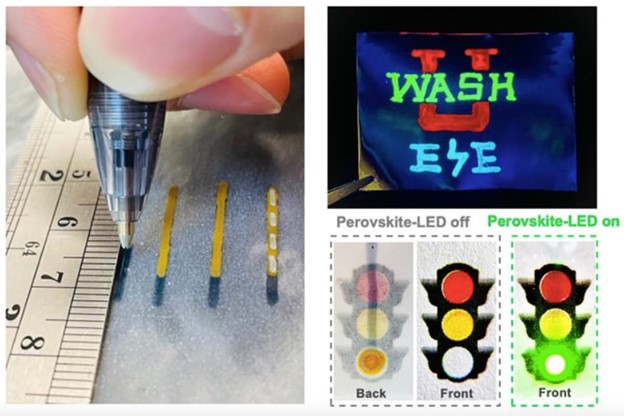
Although we’re hearing more about stretchable electronics, the fabrication of such devices’ components is far beyond most people’s abilities. Now, however, scientists have created inks that let anyone draw stretchable LEDs onto various surfaces, including fabric, using regular ballpoint pens.
The inks were produced at Washington University, St. Louis, Mo., by a team led by Assoc. Prof. Chuan Wang and graduate student Junyi Zhao. Previously, the team of scientists had developed inks that could be used to produce stretchable LEDs via an inkjet printer.
Adapting those inks for use in ballpoint pens involved adjusting their wettability (a liquid’s ability to maintain contact with a solid surface) and improving their writability. The researchers also had to boost their ability to be applied to a porous or fibrous surfaces, such as paper or fabric, without running or mixing with one another.
Ordinarily, LEDs are put together sort of like sandwiches. They’re made up of at least three layers: an anode layer, an emissive layer and a cathode layer. The three pen inks, which are separately applied one over the other without mixing, perform these roles. One ink incorporates conductive polymers, one contains metal nanowires, and one incorporates crystalline materials known as perovskites. When connected to an electrical current, this flexible, stretchable combination of inks is capable of emitting a wide range of colors.
“Cheap, customizable LEDs open up opportunities for hands-on education, more vivid textiles, such as clothing that lights up, greeting cards and smart packaging,” said Wang. “One area we’re really excited about is medical applications. Handwritten light emitters and detectors allow more patient-specific flexibility in creating wearable biomedical sensors and bandages that could have photodetectors and infrared LEDs drawn onto them for measuring pulse oximetry or to speed wound healing.”
A paper on the research was recently published in the journal Nature Photonics.
Source: Washington University, St. Louis via www.newatlas.com.
 TEXTILES.ORG
TEXTILES.ORG


